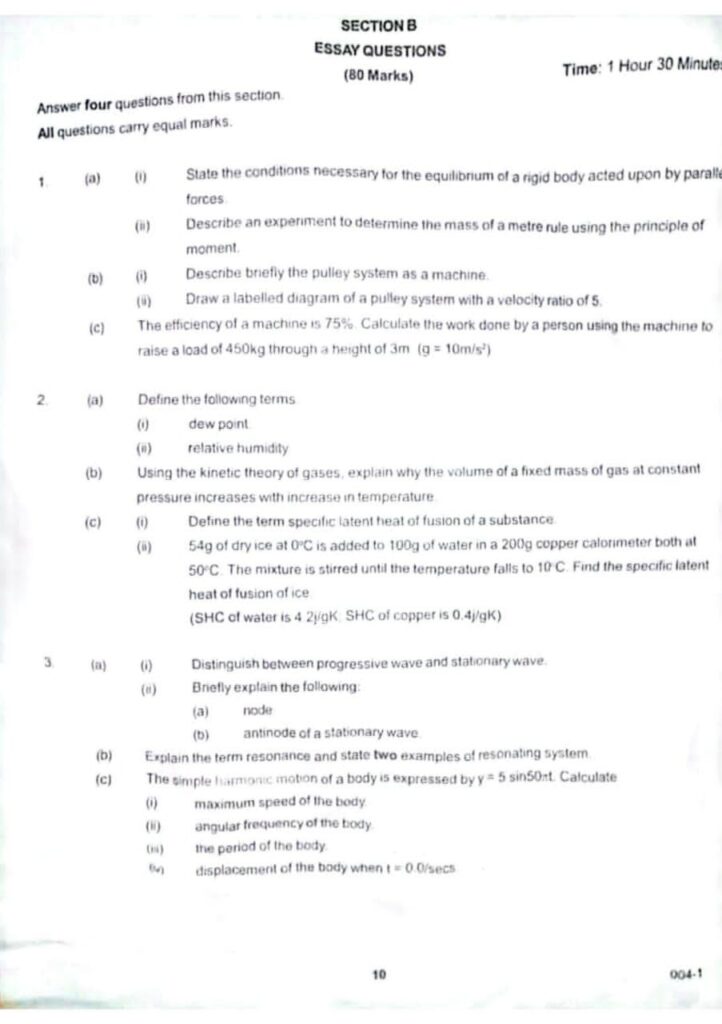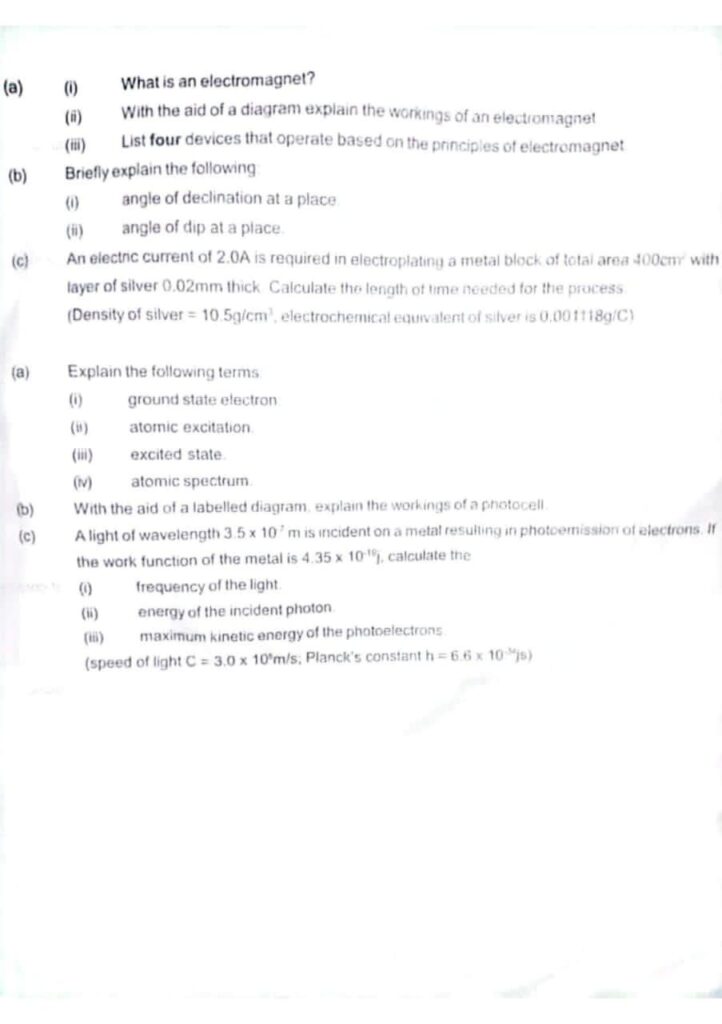
NABTEB 2024 PHYSICS QUESTIONS;-ExamgrandComNg


👇🏾
OBJECTIVES
01-10: BDBADCDDCC
11-20: DBBBDDCBCA
21-30: DBDCBDDCBD
31-40: ABCCACCCDB
41-50: ABCDACDAAB
COMPLETED
NABTEB PHYSICS ESSAY
(1ai)
(i) The algebraic sum of all the forces acting in one direction must be zero.
(ii) The algebraic sum of all the forces acting in the perpendicular direction must be zero.
(iii) The algebraic sum of all the moments about any point in the body must be zero.
(1aii)
To determine the mass of a meter rule using the principle of moments, suspend the rule horizontally from a pivot point and hang known masses at measured distances from the pivot until the rule balances horizontally. Using the principle that the sum of clockwise moments equals the sum of anti-clockwise moments, calculate the mass of the meter rule by equating the product of the unknown mass and its distance to the pivot with the sum of the known masses multiplied by their distances from the pivot.
(1bi)
A pulley system is a simple machine that consists of a wheel with a groove and a rope or belt that wraps around the wheel. By changing the direction of the force required to lift an object, a pulley system allows for the easier lifting of heavy objects. It works on the principle of mechanical advantage, making it easier to lift or move heavy loads by distributing the force needed.
(1bii)
(Draw the diagram)
(1c)
Given:
Efficiency (η) = 75% = 0.75
Mass of load (m) = 450kg
Height (h) = 3m
Acceleration due to gravity (g) = 10m/s²
Work done against gravity:
W = mgh
W = 450x10x3
W = 13,500 joules
Total work done:
Input work = Output work/Efficiency
Input work = 13500/0.75
Input work = 18,000 joules
======================================
(2a)
(i) Dew point is the temperature at which air becomes saturated with moisture and can no longer hold all of its water vapor, causing condensation to occur.
(ii) Relative humidity is a measure of the amount of moisture in the air relative to the maximum amount of moisture the air can hold at a specific temperature.
(2b)
According to the kinetic theory of gases, the average kinetic energy of gas molecules is directly proportional to the temperature of the gas. When the temperature of a fixed mass of gas at constant pressure increases, the average kinetic energy of its molecules increases. This increase in kinetic energy causes the molecules to move faster and collide with the walls of the container more frequently and with greater force. As a result, the pressure of the gas increases, leading to an expansion of the gas and an increase in volume to maintain the pressure constant.
(2ci)
The specific latent heat of fusion of a substance is the amount of heat energy required to change the state of a unit mass of the substance from solid to liquid at its melting point without any change in temperature.
(2cii)
Given data:
Mass of dry ice (mCO₂) = 54 g
Initial temperature of dry ice (TCO₂) = 0°C
Mass of water (mw) = 100 g
Initial temperature of water (Tw) = 50°C
Mass of copper calorimeter (mCu) = 225 g
Initial temperature of copper (TCu) = 50°C
Final temperature (Tf) = 10°C
Specific heat capacity of water (cw) = 4.2 J/g/K
Specific heat capacity of copper (cCu) = 0.4 J/g/K
Specific latent heat of fusion of ice (Lf) = ?
Heat lost by water:
Qw = mw x cw x (Tw – Tf)
Qw = 100 x 4.2 x (50 – 10)
Qw = 100 x 4.2 x 40
Qw = 16,800J
Heat lost by copper calorimeter:
QCu = mCu x cCu x cdot (TCu – Tf)
QCu = 225 x 0.4 x (50 – 10)
QCu = 225 x 0.4 x 40
QCu = 3600J
Total heat lost by water and calorimeter:
Qtotal = Qw + QCu
Qtotal = 16800 + 3600
Qtotal = 20400J
Heat gained by dry ice:
Qdry ice = mCO₂ x Lf
20400 = 54 x Lf
Lf = 20400/54
Lf = 377.78 J/g
======================================
(3ai)
(i) Progressive waves move energy from one point to another while stationary waves do not transfer energy.
(ii) Progressive waves have identifiable crests and troughs while stationary waves have nodes and antinodes.
(iii) Progressive waves can be observed traveling in a medium while stationary waves appear to be standing still in a medium.
(iv) Progressive waves have a definite frequency and wavelength while stationary waves have a fixed pattern of nodes and antinodes.
(v) Progressive waves exhibit a continuous variation in amplitude while stationary waves have points with zero amplitude.
(3aii)
(i) A node refers to a point along the medium where the displacement of the wave is always zero. Nodes occur at fixed points of zero amplitude in a standing wave pattern.
(ii) An antinode of a stationary wave is a point of maximum amplitude oscillation where the particles of the medium undergo the maximum displacement from equilibrium. Antinodes occur at points between adjacent nodes in a standing wave pattern.
(3b)
Resonance occurs when a system vibrates at its natural frequency in response to an external stimulus, amplifying the resulting vibrations. Two examples of resonating systems include a swing being pushed at just the right moment to increase its motion and a glass shattering when exposed to a sound wave vibrating at its resonant frequency.
(3c)
(i) Maximum speed of the body (Vmax):
General equation: y = A sinwt
Given equation: y = 5 sin50πt
Maximum speed Vmax = 2πfA
Amplitude of oscillation (A) = 5cm
Angular frequency (w) = 50π rad/s
Vmax = Aw
Vmax = 5 x 50π
Vmax = 250π cm/s
(ii) Angular frequency of the body (w):
y = A sinwt ; y = 5 sin50πt
Comparing the equations:
w = 50π rad/s
(iii) Period of the body (T):
Period T = 2π/w
T = 2π/50π
T = 0.04s
(iv) Displacement of the body (y) when t = 0:
y = 5 sin50πt
y = 5 sin (50π x 0)
y = 0cm
======================================
(4ai)
An electromagnet is a type of magnet in which the magnetic field is produced by an electric current.
(4aii)
(Draw the diagram)
An electromagnet is created by passing an electric current through a coil of wire. The current generates a magnetic field around the wire, turning it into a magnet. The strength of the magnet can be controlled by adjusting the amount of current flowing through the wire.
(4aiii)
(i) Electric motors
(ii) Generators
(iii) Transformers
(iv) Solenoids
(4bi)
(i) The angle of declination at a place is the angle between true north and magnetic north at that location. It indicates how much the Earth’s magnetic field deviates from true north at that particular point on the Earth’s surface.
(ii) The angle of dip at a place is the angle between the direction of the Earth’s magnetic field lines and the horizontal plane at that location. It represents the inclination of the magnetic field with respect to the Earth’s surface, indicating how steeply the magnetic field lines are dipping into or rising out of the ground.
(4c)
Given:
Current (I) = 2.0A
Area (A) = 400cm²
Thickness of silver layer (d) = 0.02 mm
Density of silver (ρ) = 10.5g/cm³
Electrochemical equivalent of silver (E) = 0.001118g/C
Thickness of silver layer (d) to cm:
d = 0.02 x 0.1
d = 0.002cm
Volume of silver deposited (V):
V = A x d
V = 400 x 0.002
V = 0.8cm³
Mass of silver deposited (m):
m = ρ x V
m = 10.5 x 0.8
m = 8.4g
Total charge required (Q):
Q = m/E
Q = 8.4/0.001118
Q = 7517.89C
Time required (t):
Q = It
t = QI
t = 7517.89 x 2.0
t = 3758.94 seconds
======================================
(5a)
(i) Ground state electron: This refers to an electron in an atom that occupies the lowest energy level available to it. In the ground state, the electron is in its most stable configuration around the nucleus.
(ii) Atomic excitation: Atomic excitation occurs when an electron in an atom absorbs energy, typically through collisions with other particles or through exposure to electromagnetic radiation. This absorbed energy can cause the electron to move to a higher energy level.
(iii) Excited state: An excited state of an atom occurs when one or more of its electrons have absorbed energy and moved to a higher energy level than their ground state. Electrons in this state are less stable and can quickly transition back to lower energy levels, releasing energy in the form of light or heat.
(iv) Atomic spectrum: An atomic spectrum is a unique set of wavelengths or frequencies of electromagnetic radiation emitted or absorbed by atoms when electrons transition between different energy levels. These spectra are used to identify elements and study their behavior at the atomic level.
(5b)
(Draw the diagram)
A photocell is a type of light sensor that changes its resistance based on the amount of light it is exposed to. When light hits the photocell, the electrons in the material become excited, causing its resistance to decrease. This change in resistance can be used to detect the presence or absence of light in various applications such as automatic lighting systems or solar panels.
(5c)
Given:
Wavelength of light (λ) = 3.5×10⁻⁷m
Work function of the metal (ɸ) = 4.35×10⁻¹⁹J
Speed of light (c) = 3.0×10⁸m/s
Planck’s constant (h) = 6.6×10⁻³⁴Js
(i) Frequency of the light (f):
f = cλ
f = 3.0 x 10⁸ x 3.5×10⁻⁷
f = 8.57 x 10¹⁴Hz
(ii) Energy of the incident photon (E):
E = hf
E = 6.6×10⁻³⁴ x 8.57×10¹⁴
E = 5.65×10⁻¹⁹J
(iii) Maximum kinetic energy of the photoelectrons (Kmax):
Kmax = E – ɸ
Kmax = (5.65×10⁻¹⁹) – (4.35×10⁻¹⁹)
Kmax = 1.30×10⁻¹⁹J
===========================






Be the first to comment